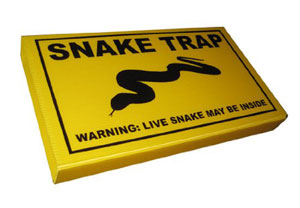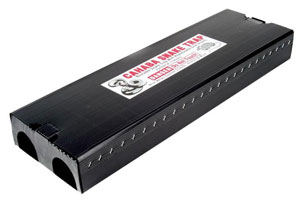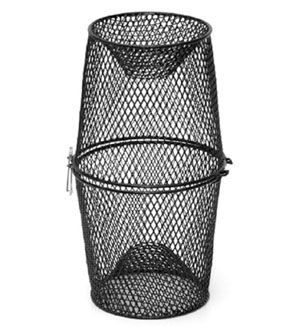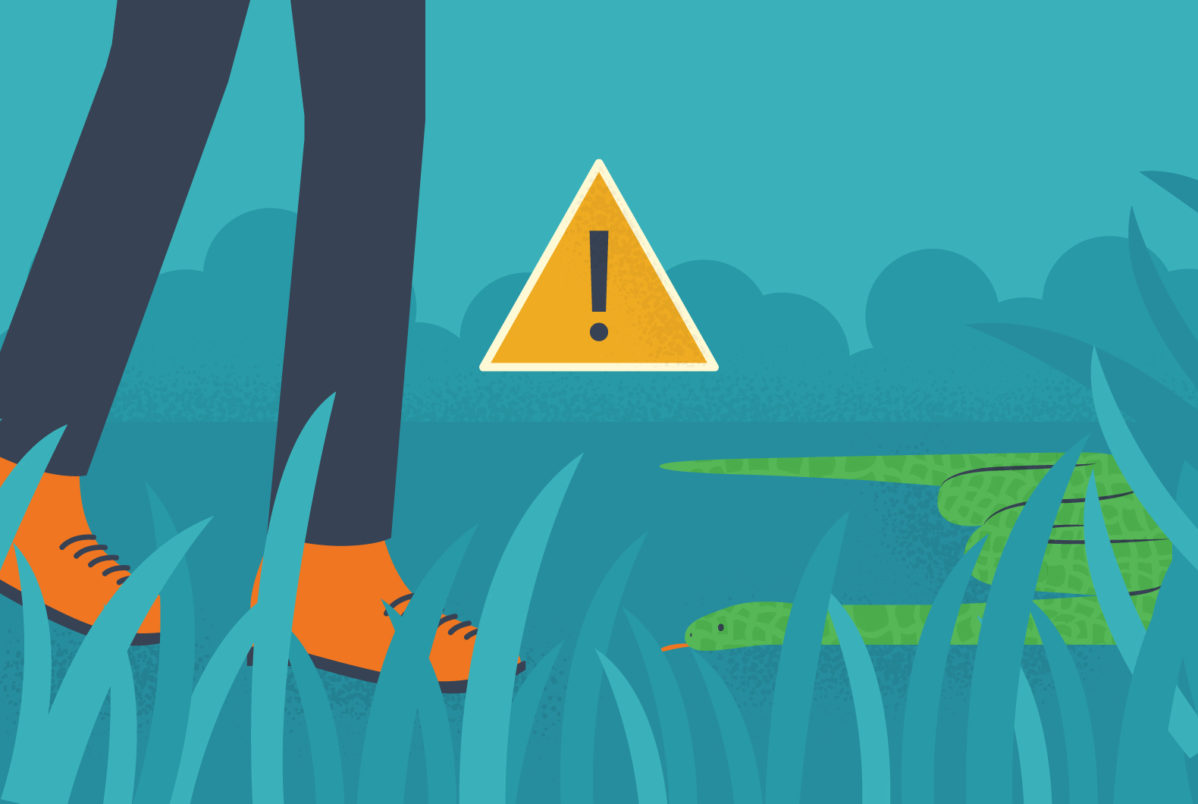

This article was written by Connor, one of our founding editors. Connor is a full-time travel and lifestyle photographer with extensive experience in the outdoors industry.
Do you want to make your yard a snake-free environment for you, your children, and your pets? I’m here to help you chose the best snake trap for your situation.
Depending on the area you live, snakes can be fairly prevalent. Fortunately, they tend not to do too much damage to yards and houses but they can certainly pose a threat. When removing them, a snake trap is one of the best and safest ways to do so.
In the time I spent doing our research on the best snake traps on the market, I found plenty of inhumane ones out there. I’ve deliberately not included these in our reviews as I feel it is simply not fair on a creature which is doing no wrong. The best kind of snake trap is the one which causes the least harm to both you and snake!
There are a variety of different styles of traps you can get and it is difficult to know which is the most effective one. That’s why I’ve covered a selection in this review guide. Generally, it comes down to personal preference and the space you’ll be placing it.
 Simply named ‘Snake Trap’, this is one of the most popular options on the market. It is a glue trap with a bright design so that it can be easily spotted. This trap has been well-built to withstand poor weather conditions, as well as functioning suitably indoors.
Simply named ‘Snake Trap’, this is one of the most popular options on the market. It is a glue trap with a bright design so that it can be easily spotted. This trap has been well-built to withstand poor weather conditions, as well as functioning suitably indoors.
The manufacturer states that ‘dots’ on the glue can attract snake within a 10ft radius. Additionally, the design is said to be attractive to snakes given that it is similar to a natural den.
What We Like
With this trap, we love how easy it is to set up and then release a snake, should you catch one. Simply lay the box down on or near where you saw the snake and check periodically. To release the snake, use cooking oil and it will gradually be able to move freely.
What We Don’t Like
Although there are countless reports of this trap working very effectively, there are also many which state that the box is too flimsy. Take the negative reviews with a pinch of salt. Many simply state “didn’t catch anything”. There are too many variables to determine whether this is down to the product, whether it was put in the wrong place or if the snake had already moved on.
 This commercial-grade trap has three replaceable inserts for catching small snakes. The highly durable plastic box has been designed for both indoor and outdoor use. In this guide, we’re reviewing two of Cahaba’s traps. This one, at 16 inches long, is targeted more toward catching smaller snakes. As well as this, it is equally effective for controlling mice, rats, lizards, and spiders.
This commercial-grade trap has three replaceable inserts for catching small snakes. The highly durable plastic box has been designed for both indoor and outdoor use. In this guide, we’re reviewing two of Cahaba’s traps. This one, at 16 inches long, is targeted more toward catching smaller snakes. As well as this, it is equally effective for controlling mice, rats, lizards, and spiders.
What We Like
There is absolutely no set up required, you simply place the trap where it is needed and let it do the work. As with other similar traps, there is the potential you will catch nothing because snakes are unpredictable and can move on. That said, when you do catch a snake, the glue is effective at holding it and it can then be easily released.
What We Don’t Like
It’s hard to knock this trap because it is highly durable and seems to work effectively. Again, the main criticism we see is that nothing was caught with it. A few others state that a similar device could be made cheaper if you were to do it yourself. However, you always take a risk when making your own trap.
 The final glue trap in our reviews is another from Cahaba. This time, the glue trap is designed to catch larger snakes, coming in at 32 inches in length. Aside from size, the device itself is the same as its smaller counterpart.
The final glue trap in our reviews is another from Cahaba. This time, the glue trap is designed to catch larger snakes, coming in at 32 inches in length. Aside from size, the device itself is the same as its smaller counterpart.
What We Like
Again, this device is incredibly easy to use with no harm to either you or the snake. Given that you place it in the right place, there is no need to bait it. However, others have found more success in putting bait in the trap.
What We Don’t Like
A common negative review on this device is that there is nothing to hold down the sticky material, with one specific review claiming that the glue strip got stuck to the inside of the trap which put it out of action.
 Stepping away from the glue traps, we’re now looking at alternative options. Although not specifically designed to catch snakes, there has been a definite rise in the use of minnow traps.
Stepping away from the glue traps, we’re now looking at alternative options. Although not specifically designed to catch snakes, there has been a definite rise in the use of minnow traps.
What We Like
The advantage of minnow traps is that you can easily see if there is a snake inside. The Eagle Claw trap can be split into two for ease of storage and transportation. Since it has been designed for aquatic use, it is durable in different weather conditions.
What We Don’t Like
The main criticism is that it is much harder to remove a snake from this kind of trap than a glue or box trap. This is no complaint of any specific brand, but minnow traps in general. You need to be very careful that you don’t stick your fingers into the mesh and risk getting bitten.
This is a heavy-duty steel mesh trap, similar to the Eagle Claw minnow trap. The 2-piece construction makes removal easier, but as we mentioned, there is still a greater risk of danger using a minnow trap rather than a snake-specific trap.
What We Like
This trap has slightly larger entry holes since it is designed for crawfish rather than minnows. This means that it’ll be better suited if you are trying to trap large snakes. Additionally, it is highly durable and will hold up well outside.
What We Don’t Like
There aren’t many negatives about this trap. There are a handful of complaints about it falling apart having been thrown a few times, but since you’ll be using it to catch snakes then this won’t be a problem.

Snakes are often protected by state law, which means you’ll need to consider your removal options very carefully. For example, indiscriminate killing may be completely illegal. Additionally, relocation of captured snakes (if to an entirely different area, at least) should only be done after consulting your local Parks and Wildlife Department.
With the cost of treating a venomous snake bite being in the thousands of dollars, you might want to think twice about trapping them on your own.
Like choosing any product, there are always considerations before you click ‘purchase’ and check out. One of the main considerations in snake removal is deciding if you should be doing it yourself or calling in the professionals.
Snakes, especially venomous ones, can cause nasty bites and you don’t want to be rushing to ER and forking over the hefty medical bills if it all goes south. That said, snake traps are designed to be a relatively safe way to remove them and they’re pretty easy to use.
If you’re at all concerned or not sure what to do, a professional snake removal service is only a phone call away and it will give you the peace of mind that the snake has been removed humanely, without harm to yourself.
Snakes are often protected by state law, which means you’ll need to consider your removal options very carefully. For example, indiscriminate killing may be completely illegal. Additionally, relocation of captured snakes (if to an entirely different area, at least) should only be done after consulting your local Parks and Wildlife Department.
As we said, there are so many different kinds of traps out there. Some of them are excellent and some will do more harm than good. Out of all the possibilities, most choices end up coming down to either a glue trap or minnow trap.
A glue trap is likely the most popular type of snake trap due to its ease of use and size.
They can be tucked away neatly and will fit under fairly small spaces. The idea is that the snake will be baited into the opening of the trap and get stuck to the adhesive layer, therefore unable to escape. Usually, the adhesive layer is scented, which is what lures the snake in there in the first place.
You should look for a glue trap which is highly durable and suitable for both indoor and outdoor use i.e. will hold up well in poor weather. If the trap isn’t made out of something durable, the snake will have a higher chance of breaking free.
Once the snake has been trapped, it is rendered completely immobile yet safe and unharmed. To release it, you can spray cooking oil onto the adhesive layer. It won’t release immediately, but it should be able to work its way out not long after.
The clue is in the name here; minnow traps are designed for a more aquatic environment. In the snake removal world, though, they are becoming far more popular. One of the reasons for this is that you can actually see whether a snake as been caught or not, without having to get too close.
Due to the fact they haven’t been designed for snakes, it’s hard to say exactly how effective they are. We have seen that many people are having success using this method and prefer using it over the glue.
In order to use it effectively, you will need to bait the snake with some form of food. The snake will climb in and be unable to find the way out. Removing a snake from a minnow trap is harder than a glue trap because the snake is still completely mobile.
We’d recommend that you also invest in a snake tong and hook in order to remove the snake from this trap. This will allow you to have enough control over it to remove it safely.
Placing a snake trap is fairly straight forward; put it where the snakes are frequenting. They will be most effective when used indoors because you are unlikely to catch any other animals, like rats or birds.
Traps also work very well outdoors. Place it where you believe the snake tends to linger. This is usually under some form of cover such as decking or bush. If you haven’t caught anything by a few days, it probably means the snake has gone.
Understandably, snakes cause a lot of fear in people. We believe this is largely due to a lack of understanding. As fierce as they look, snakes would much rather not strike you and where possible, it’s always best to keep your distance.
Even from the venomous snakes, there are relatively few bites (roughly 8000 per year) and less than a handful of these bites each year results in death. A snake will likely only ever strike you if it feels threatened, which will mean you either got too close or caused it pain.
If they’re in your garden, snakes will actually be more helpful than harmful. Of course, we understand that they can be dangerous for children and animals. However, they do an excellent job of keeping rodents and insects away. Unlike rats, they’re also not going to go through your home biting into every wire and causing havoc.
As much as you don’t want snakes to roam free and endanger your pets or children, I’m sure you’ll agree that it is unfair to let an animal suffer.
Although snake traps are humane, the main problem with them is that people often forget to check them regularly. If you put down a trap, make sure that you check it periodically. It is unfair to leave a snake in a trap for a long time and if left for too long, it will starve to death.